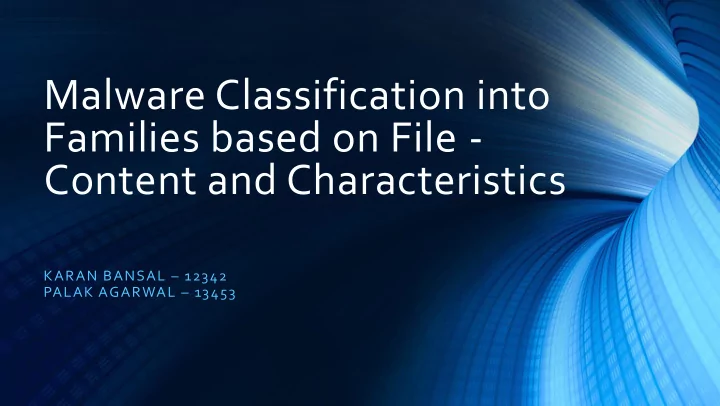

Malware Classification into Families based on File - Content and Characteristics KARAN BANSAL – 12342 PALAK AGARWAL – 13453
Motivation • One of the major challenges faced by anti-malware today is the vast amount of data and files which needs to be evaluated for potential malicious content. • Tens of millions of data points are generated daily to be analyzed as potential malware. • Malware authors use automated techniques like Polymorphism in order to evade ‘pattern matching’ detection. • Malware must be defined semantically as the same Virus, Worm, Trojan, Key Logger etc. is likely to exist in different physical forms.
Polymorphic Malware • Polymorphism loosely means – ‘change the appearance of’. • Spyware which constantly changes (‘morphs’) itself, making it difficult to detect with anti-malware programs. • Generates a unique instance of a malware family for each victim, to create new malware. • Evolution of malicious code can occur in a variety of ways such as filename changes, compression and encryption with variable keys.
Problem Statement and Challenge • Training the classifier using the training data and then classifying the malware files (binary executables) in the test data into 9 categories of malwares. • Identifying the classifying features in the byte code as well as asm file for each malware into their respective classes. • Dataset is too large as compared to available computation power and resources. • Appearance of malware (code) is different in every file making it difficult to identify common features of each class.
Data Set • Participating in Microsoft Malware Challenge and the training as well as test dataset is provided by Kaggle. • For every binary – byte code and disassembled asm file. • Training set – 200 GB (10.8k asm files and 10.8k bytes files) • Test set – 200 GB (10.8k asm files and 10.8k bytes files) • Asm file – (0.4 millions – 19 millions lines) • Bytes file – (150k - 180k lines)
Methodology • Random Forest Classifier • SVM • Naïve-Bayes Classifier • K-Nearest Neighbors • N-gram based File Signatures • K-Fold Cross Validation
Proposed Features • Frequency of 256 possible hex values in the bytes file corresponding to each malware. • Frequency of 256 possible hex values at specific position in the asm file corresponding to each malware. • Frequency of various instructions like mov, jmp etc. in the asm file corresponding to each malware. • N-gram based File Signatures
Submission and Score Calculation • For each malware file we’ll submit a set of predicted probabilities : (one for every class) • Each file has been labelled with one true class. • Evaluation is done using Multi-Class Logarithmic Loss. • • Minimize the log loss to achieve higher accuracy.
Current Progress • Applied Random Forest Classifier on bytes files with frequency of 256 hex values as features achieving a score of 0.1929345. • Applied Random Forest Classifier on asm files and code is running on the machines. • Explored the asm and bytes files and figured out some distinguishing patterns in malwares corresponding to nine families. * Code of random forest classifier taken from Vishnu Chevli (github.com/vrajs5/Microsoft-Malware-Classification-Challenge).
REFERENCES : • Bilar , Daniel. ”Statistical structures: Fingerprinting malware for classification and analysis.” Proceedings of Black Hat Federal 2006 (2006 ). • Griffin, Kent, et al. ”Automatic generation of string signatures for malware detection.” Recent Advances in Intrusion Detection. Springer Berlin Heidelberg, 2009. • Santos, Igor, et al. ”N -grams-based File Signatures for Malware Detection.”ICEIS (2) 9 (2009): 317-320. • Raman, Karthik . ”Selecting features to classify malware.” InfoSec Southwest(2012).
Thank You Any Questions?
Recommend
More recommend